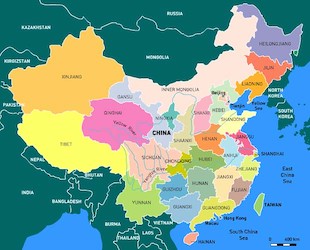
People’s Republic of China (中国). A country in East Asia known as “China.” With a population exceeding 1.4 billion, it is the world’s second-most populous country after India and contains 17.4% of the world population. China spans the equivalent of five time zones and borders fourteen countries by land. With an area of nearly 9.6 million square kilometers (3,700,000 sq mi), it is the third-largest country by total land area. The country is divided into 33 province-level divisions: 22 provinces, five autonomous regions, four municipalities, and two semi-autonomous special administrative regions. Beijing is the country’s capital, while Shanghai is its most populous city by urban area and largest financial center.
A cradle of civilization, China has been inhabited for thousands of years before the Common Era. The eighth to third centuries BCE saw a breakdown in the authority of the Zhou dynasty, accompanied by the emergence of administrative and military techniques, literature, philosophy, and historiography.
In 221 BCE, China was unified under an emperor for the first time. Appointed non-hereditary officials began ruling counties instead of the aristocracy, ushering in more than two millennia of imperial dynasties including the Qin, Han, Tang, Yuan, Ming, and Qing. With the invention of gunpowder and paper, the establishment of the Silk Road, and the building of the Great Wall, Chinese culture—including languages, traditions, architecture, philosophy and technology—flourished and has heavily influenced East Asia and beyond. However, China began to cede parts of the country in the late 19th century to various European powers by a series of unequal treaties.
After decades of struggle, the monarchy was overthrown in 1912 and the Republic of China (ROC) was formed, although the country became unstable which resulted in the Warlord Era, that later concluded after the Kuomintang (KMT) reunified the country while the Chinese Communist Party (CCP), purged after 1927, were fighting sporadically against the Nationalist government, with a brief truce as a united front during the Japanese Invasion.
Despite China’s eventual victory in the Second Sino-Japanese War and the Pacific War in general, numerous atrocities such as the Nanjing Massacre left lasting effects on the country. After the war ended, it recovered the territories that Japan annexed but the second phase of the Chinese Civil War resumed shortly after, and by 1949, the CCP had established control on most of the territories of the country.
As the KMT retreated to the island of Taiwan, the country was split with both sides claiming to be the sole legitimate government of China. After the land reforms, later attempts to realize communism failed—the Great Leap Forward led to a massive famine of millions of citizens, while the Cultural Revolution caused a chaotic period of persecution and zealous Maoist populism.
In 1971, the PRC replaced the ROC as China’s representation in the United Nations. Following the Sino-Soviet split, the Shanghai Communiqué in 1972 marked the beginning of normalized relations with the U.S. Economic reforms that began in 1978 led by reformists within the CCP moved the country away from a socialist planned economy toward an increasingly capitalist market economy, spurring significant economic growth, although liberal and democratic political reforms stalled after the Tiananmen Square massacre in 1989.
China is a unitary one-party socialist republic led by the CCP. One of the five permanent members of the U.N. Security Council. Making up around one-fifth of the world economy, the Chinese economy is the world’s largest economy by GDP at purchasing power parity, the second-largest economy by nominal GDP, and the second-wealthiest country. The country has been one of the fastest-growing major economies and is the world’s largest manufacturer and exporter, as well as the second-largest importer.
China is a nuclear-weapon state with the world’s largest standing army by military personnel and the second-largest defense budget. It is a great power and a regional power, albeit ranking poorly in measures of democracy, human rights, and religious freedom. China is known for its cuisine, culture and has 57 UNESCO World Heritage Sites.